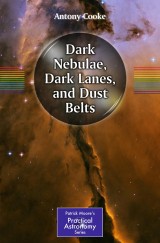Details

Dark Nebulae, Dark Lanes, and Dust Belts
The Patrick Moore Practical Astronomy Series
|
42,79 € |
|
| Verlag: | Springer |
| Format: | |
| Veröffentl.: | 28.01.2012 |
| ISBN/EAN: | 9781461411864 |
| Sprache: | englisch |
| Anzahl Seiten: | 243 |
Dieses eBook enthält ein Wasserzeichen.
Beschreibungen
<p>There are 'voids' obscuring all kinds of objects in the cosmos. Voids may be within an object, or between an object and us. <i>Dark Nebulae, Dark Lanes, and Dust Lanes</i> looks out into the deep sky at those apparent dark regions in space, which are among the most compelling telescopic destinations for amateur observers. One famous example is Barnard's dark nebulae - those striking dark clouds set against the background of stars in the Milky Way. But there are countless other less well known examples. These dark regions are often ignored altogether or commented upon only briefly in astronomy books, and it is all too easy to overlook the treasure trove they offer the observer. </p><p><i>Dark Nebulae, Dark Lanes, and Dust Lanes</i> is a great source of practical information for observers. Such voids may be successfully observed using conventional observing methods, but they are often far better seen with technologies such as light-pollution filters, CCD video cameras, and image intensifiers. This book explains the optimal ways to observe each object in detail.</p>
The Nature of Unlit Gases and Dust, and Their Place in the Universe.- Defining Our Viewing Parameters and Methods.- Dark Nebulae.- Dark and Dusty Regions in Bright Diffuse Nebulae.- Dark Lanes in Star Clusters.- Dust Belts and Dark Features in Galaxies.- Dark Regions in Planetary Nebulae.- A Few Last Words.
<p>Antony Cooke's passion for both astronomy and music was clear from an early age, although it was music that ultimately claimed his career. As solo cellist he has played and recorded worldwide. He was also a professor of music at Northwestern University in Chicago. Presently, he is a prominent Hollywood studio musician, as well as a composer for prime time television. However, it has often been said that science and music go hand in hang. With applied and theoretical astronomy never being far behind, he has pursued it as a serious avocation.</p><p>As an observer always looking for ways to improve his experience at the eyepiece, Cooke has constructed many telescopes over the years. Increasing apertures were always the hallmark of his often-quirky designs. Finding that the 18-inch aperture of his present telescope was still insufficient to deliver the kind of performance he had in mind, he experimented with newer technologies to bring these elusive goals ever closer. Successful viewing of dark objects requires great contrast. In this respect, some of the newer equipment has proven to be invaluable, enabling dramatic viewing of many dark objects and features in real time and without the need of CCD imaging.</p><p>As an author of astronomy books, Cooke also has written <i>Visual Astronomy in the Suburbs</i> (Springer, 2003), <i>Visual Astronomy under Dark Skies</i> (Springer, 2005), and <i>Make Time for the Stars</i> (Springer, 2009). With <i>Dark Nebulae, Dark Lanes and Dust Belts</i>, his astronomical writings continue.</p>
<p>As probably the only book of its type, this work is aimed at the observer who wants to spend time with something less conventional than the usual fare. Because we usually see objects in space by means of illumination of one kind or another, it has become routine to see them <i>only</i> in these terms. However, part of almost everything that we see is the defining dimension of dark shading, or even the complete obscuration of entire regions in space. Thus this book is focused on everything dark in space: those dark voids in the stellar fabric that mystified astronomers of old; the dark lanes reported in many star clusters; the magical dust belts or dusty regions that have given so many galaxies their identities; the great swirling 'folds' that we associate with bright nebulae; the small dark feature detectable even in some planetary nebulae; and more.</p><p>Many observers pay scant attention to dark objects and details. Perhaps they are insufficiently aware of them or of the viewing potential they hold, but also it may be because of the various viewing challenges that dark objects pose. Discussions on viewing methods and the best equipment for a wide cross section of these objects are included, along with many detailed descriptions. The book contains virtually every dark object worth the observer's attention.</p><p>Whether viewing live through the eyepiece or indirectly through CCD or other imaging techniques, this unique compendium and discussion of all things dark in space will hopefully prove compelling and rewarding.</p>
Serves as the only resource for amateur observers who specifically set out to observe dark features in the deep sky Offers detailed descriptions of how to study dark objects, including recommendations for choosing commercial equipment Shows how practical observations of dark features can be made from suburban (light-polluted) locations Contains numerous helpful individual object descriptions and illustrations Includes supplementary material: sn.pub/extras

















